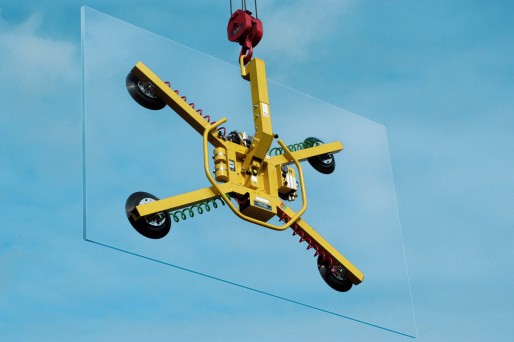Maximum wind speed for safe use is 29km/h, 18mph, 16.5 knots or 8 m/s
In this edition of GGR Group’s Guide to Safe Lifting we are looking at how to calculate the weight of your glass load and choose the right vacuum lifter for the job.
Weight
When planning a lift the first thing to be considered is the weight of the load. This will help you to narrow down your choice of lifter. The weight of a piece of glass can be calculated by using this simple formula.
Calculating glass weight to nearest kg
Length in metres x height in metres x thickness in mm x 2.5
Example: 3070mm x 2150mm x 10mm
Becomes : 3.07m x 2.15m x 10mm x 2.5 = 165 kg
If the unit of glass is double or triple glazed, the thickness of each leaf of the unit should be added together and treated as a single leaf. For example , if you have a 8.8 m leaf, 16mm air space and 4mm leaf, add the 8.8 and 4 together to get a leaf of 12.8mm (13mm). Remember, never add the air space. Finally with double glazed units, a further 2% of the total needs to be added to the weight to include the frame (spacer bar) and if it is a framed unit a further 5% is added.
Pad spread
When lifting glass, it is equally important to consider the amount of support given by the lifter’s vacuum pad frame as it is to the weight of the load.
The vacuum pads need to cover a certain area of the glass load, to ensure sufficient glass is supported to prevent the glass bending excessively and breaking, or peeling away from the pads. The amount of support required from the pad frame depends on the thickness of the glass and the maximum angle that the unit will encounter during its installation, not just on the initial lifting angle. Please remember that in case of multiple glazed units, we only need consider the thickness of the leaf the vacuum lifter will attach to. DO NOT add the thickness of the leaves together.
The chart below shows the maximum overhang allowed at different tilt angles.

From the information in this chart you can now work out what the minimum pad spread across your load should be.
To calculate the minimum pad spread dimensions:
Determine the allowable overhang for your piece of glass. For example you have a leaf 4mm thick that is going into a pitched roof at 83 degrees. Look at the chart and see where the 4mm row and 83 degree column intersect. This will indicated allowable overhang of 508mm.
Example: your glass is 2000mm x 1500mm x 4mm and you will be tilting from flat (90 degrees) to vertical (0 degrees).
From the chart the allowable overhang is 508mm
Multiply 508 x 2 = 1016
Subtract 1016mm from 2000mm = 984mm
Subtract 1016mm from 1500mm = 484mm
Therefore minimum pad spread is 984 x 484
Although following this guidance will decrease the risk of glass breakage, other factors such as flaws in the material, incorrect handling and unclean vacuum pads can result in damage.
Choosing your vacuum lifter
It is important to consider the weight, dimensions and shape of your load as the minimums when selecting a glass lifter that will offer a suitable vacuum pad configuration. Other factors such as access restrictions, may affect your choice when considering the depth of lifter and load combination.
Our glass vacuum lifters come in different shapes and often with a variety of extra frame configurations and pad number options available for optimal support across the load.
One of our bestselling vacuum lifters, the MRT4, is popular because of its flexibility; it has extending arms and repositionable vacuum pads. The Four-in-Line vacuum lifter is perfect for long slim pieces of glass, the DSL2 and DSZ2-12v can be used to lift curved glass and the Quadzilla, our highest capacity lifter, can cope with loads up 2500kg.
Vacuum pad maintenance
Before starting a lift the vacuum pads must be checked for damage and dirt. Pads should be regularly cleaned to remove dust, oil or other contaminates, as dirty pads could cause an accidental release of the load.
Soapy water is usually suitable for cleaning vacuum pads, but the pads will only remain slip resistant if they are residue free and completely dry. Cleaners that damage rubber, leave a surface film or contain harsh chemicals (solvents and petroleum based products) must never be used. The load being lifted must also be clean and dry.
If pads display any signs of significant wear and tear, cuts, slits, stiffness or a surface glaze they should not be used and need to be replaced. Pads should be replaced at least every two years.
Remember that a glass vacuum lifter should never been used in the rain or strong winds (see our safety guide on lifting in winter weather).
Trackback URL: https://www.ggrgroup.com/news/glass-lifting-safety-guide/trackback/





